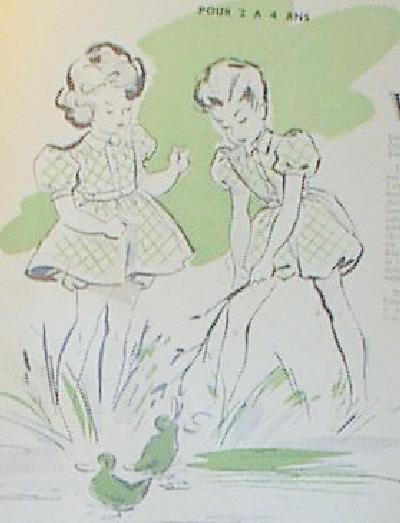
There were major fashion differences between counties in the 1940s. American and European fashions in particular were significantly different. American clothing, including children's clothing, once was significantly influenced by European fashion. This was not the case in the 1940s. Certainly World War II (1939-45) must have been a factor. European fashions of all minds were trucated by the War. Europe did not have much time for fashion in the first half of the decade. But another factor is that American boys just didn't like some of the clothes that European boys were wearing--even if there mothers did. Clothes in many countries were also influenced by military styles. After the War in 1945 many countries like England continued foofd rationing. Other countries like Germany and Italy were so devestated that that there was little money for clothes. Many boys had to continue wearing clothes or wear hand-me-downs that might have been replaced in more prosperous time. While clothing styles differed, especially between America and Europe, some trends were begun in the 1940s although they were not significantly observable until the 1950s in many countries. Styles and customs still varied considerably from country to country. Traditional styled continued in some countries onger than others. Boys in Norway and probably other Scandinavian countries continued to wear knickers and button pants longer than many other countries. Little boys and girls worn long over-the-knee stockings, but they were not popular with the boys.
The Second World War resulted in a marked austerity in dress, due in
large part to the restrictions placed on the clothing industry by the War Production Board. After the war, men were ready for another change in their clothing styles, and in 1948 the bold look began to be seen. The thumbnail summary of the 1940s was from knickers to jeans for the American boy. Knickers began to become less popular late in World War II put fashion on hold in England during the first half of the decade and rationing continued after theWar. One impact of the War was ashift toward practical clothing. . HBC notices few fashion changes in England during the 1940s. English boys continued to wear short pants suits with knee socks. Clothes were rationed and children were very limited in the clothes they could be obtained. Mothers did their best to get as much wear out of existing clothes. Many children wore hand-me-downs. Fashion was put on hold in France by first the outbreak of World War II in September 1939 and then the German victory in June 1940. French boys also commonly wore short pants during the 1940s. Liberation in 1944 and the end of the War in 1945 brought an increased interest in fashion. It was some time, however, before families could afford to spend much on children clothes. Most parents were hard pressed to affiord school lothes and at least one nice Sinday outfit. Many French mothers took uop knitting in the 40s to profuce children's clothes and knitear was widely worn by children. Sweaters behan to replace suit coats at school. School smicks were still common. Rompers (barboteuses) were popular for younger boys. The short pants worn by French boys, as was common on the Continent, wore cut shorter than was common in England. Kneesocks swere also not worn as commnly as in England--especially in ther summer. Many boys still wore smocks to school, but by the end of the decade this fashion was clearly not as common as they had been in the 1930s. Romper suits were very popular for younger boys for for play and dress occassions. Young boys might dress up in fancy blouses and short pants. Older boys wore suits. Sailor suits once very common in France, declined significantly in popularity during the 1940s.
The disruptions of the War meant that a lot of families didn't have a lot of money for clothes of any kind. German cities and industry were leveled. Jobs did not exist. People were near the starvation level. As as a result, most families made do with what ever clothes were at hand. Many boys went barefoot. Some teenagers wore their short pants suits longer than they might have if money had been available for a new suit. Quite a number of older German boys wore short pants, even short pants suits in the desperate years following the War.
The Russian peolple suffered gret privation during World War II. Stalin's Non-Agression Pact in August 1939 made him apartner in agression with Hitler. The German invasion in June 1941 wrought a leve of destruction unparalled in modern history. Clothing must have been severly limited, but we have few details.
Navigate the Historic Boys' Clothing Web Site:
England

Figure 2.--Mode pratique in April 1947 showed French children playing by a pond in matching gingham outfits. The girl wears a dress and the boy a romper suit. The top part of the dress and romper are identical.
France
Germany
Italy
Russia
HBC
[About Us]
[Introduction]
[Activities]
[Biographies]
[Chronology]
[Clothing styles]
[Countries]
[Girls]
[Theatricals]
[Topics]
[Bibliographies]
[Contributions]
[FAQs]
[Glossaries]
[Images]
[Index]
[Links]
[Registration]
[Tools]
[Boys' Historical Clothing Home]
[Return to the Main chronolgy page]
[The 1900s]
[The 1910s]
[The 1920s]
[The 1930s]
[The 1940s]
[The 1950s]
[The 1960s]
[The 1970s]
[The 1980s]
[The 1990s]
[Knickers]
[Short pants]
[Short pants suit]
[Long pants suit]
[Kilts]
[Sailor suits]
[School uniforms]
[Ring bearer/page costumes]
Created: January 26, 2001
Last updated: March 4, 2003
